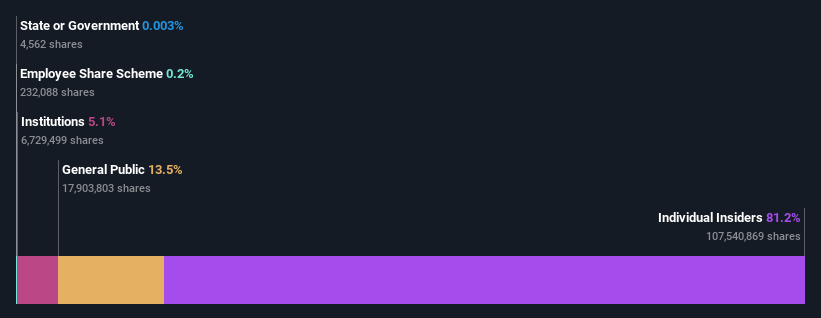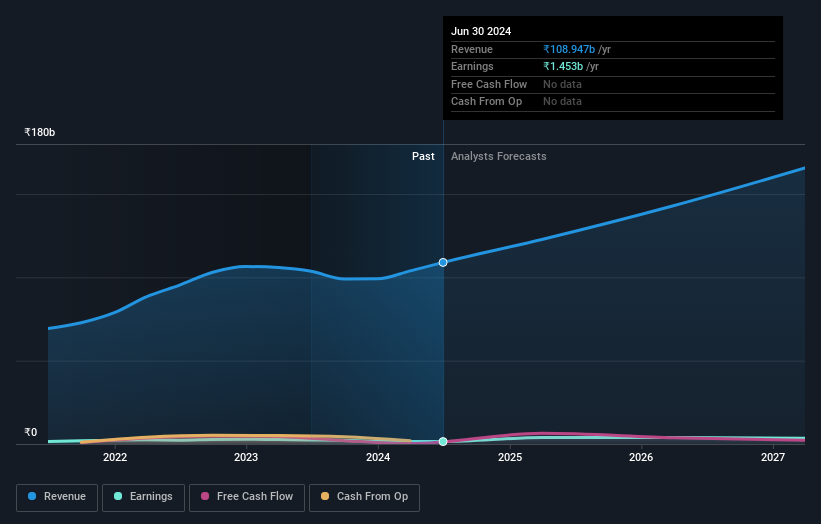Insiders were the key beneficiaries as PDS Limited's (NSE:PDSL) market cap rises to ₹76b
Key Insights
- Insiders appear to have a vested interest in PDS' growth, as seen by their sizeable ownership
- 53% of the company is held by a single shareholder (Payel Seth)
- Using data from company's past performance alongside ownership research, one can better assess the future performance of a company
A look at the shareholders of PDS Limited (NSE:PDSL) can tell us which group is most powerful. And the group that holds the biggest piece of the pie are individual insiders with 81% ownership. In other words, the group stands to gain the most (or lose the most) from their investment into the company.
As a result, insiders were the biggest beneficiaries of last week’s 5.9% gain.
Let's take a closer look to see what the different types of shareholders can tell us about PDS.
Check out our latest analysis for PDS

What Does The Institutional Ownership Tell Us About PDS?
Institutions typically measure themselves against a benchmark when reporting to their own investors, so they often become more enthusiastic about a stock once it's included in a major index. We would expect most companies to have some institutions on the register, especially if they are growing.
We can see that PDS does have institutional investors; and they hold a good portion of the company's stock. This can indicate that the company has a certain degree of credibility in the investment community. However, it is best to be wary of relying on the supposed validation that comes with institutional investors. They too, get it wrong sometimes. If multiple institutions change their view on a stock at the same time, you could see the share price drop fast. It's therefore worth looking at PDS' earnings history below. Of course, the future is what really matters.

We note that hedge funds don't have a meaningful investment in PDS. Looking at our data, we can see that the largest shareholder is Payel Seth with 53% of shares outstanding. This essentially means that they have extensive influence, if not outright control, over the future of the corporation. With 12% and 5.2% of the shares outstanding respectively, Deepak Seth and Sanjivbhai Shah are the second and third largest shareholders.
Researching institutional ownership is a good way to gauge and filter a stock's expected performance. The same can be achieved by studying analyst sentiments. There is some analyst coverage of the stock, but it could still become more well known, with time.
Insider Ownership Of PDS
The definition of an insider can differ slightly between different countries, but members of the board of directors always count. Management ultimately answers to the board. However, it is not uncommon for managers to be executive board members, especially if they are a founder or the CEO.
I generally consider insider ownership to be a good thing. However, on some occasions it makes it more difficult for other shareholders to hold the board accountable for decisions.
Our information suggests that insiders own more than half of PDS Limited. This gives them effective control of the company. So they have a ₹62b stake in this ₹76b business. It is good to see this level of investment. You can check here to see if those insiders have been buying recently.
General Public Ownership
With a 14% ownership, the general public, mostly comprising of individual investors, have some degree of sway over PDS. While this group can't necessarily call the shots, it can certainly have a real influence on how the company is run.
Next Steps:
While it is well worth considering the different groups that own a company, there are other factors that are even more important. Consider risks, for instance. Every company has them, and we've spotted 2 warning signs for PDS you should know about.
If you are like me, you may want to think about whether this company will grow or shrink. Luckily, you can check this free report showing analyst forecasts for its future.
NB: Figures in this article are calculated using data from the last twelve months, which refer to the 12-month period ending on the last date of the month the financial statement is dated. This may not be consistent with full year annual report figures.
New: Manage All Your Stock Portfolios in One Place
We've created the ultimate portfolio companion for stock investors, and it's free.
• Connect an unlimited number of Portfolios and see your total in one currency
• Be alerted to new Warning Signs or Risks via email or mobile
• Track the Fair Value of your stocks
Have feedback on this article? Concerned about the content? Get in touch with us directly. Alternatively, email editorial-team (at) simplywallst.com.
This article by Simply Wall St is general in nature. We provide commentary based on historical data and analyst forecasts only using an unbiased methodology and our articles are not intended to be financial advice. It does not constitute a recommendation to buy or sell any stock, and does not take account of your objectives, or your financial situation. We aim to bring you long-term focused analysis driven by fundamental data. Note that our analysis may not factor in the latest price-sensitive company announcements or qualitative material. Simply Wall St has no position in any stocks mentioned.
About NSEI:PDSL
PDS
Together its subsidiaries, designs, develops, sources, manufactures, markets, and distributes various readymade garments and other consumer products worldwide.
Excellent balance sheet with reasonable growth potential.
Market Insights
Community Narratives



